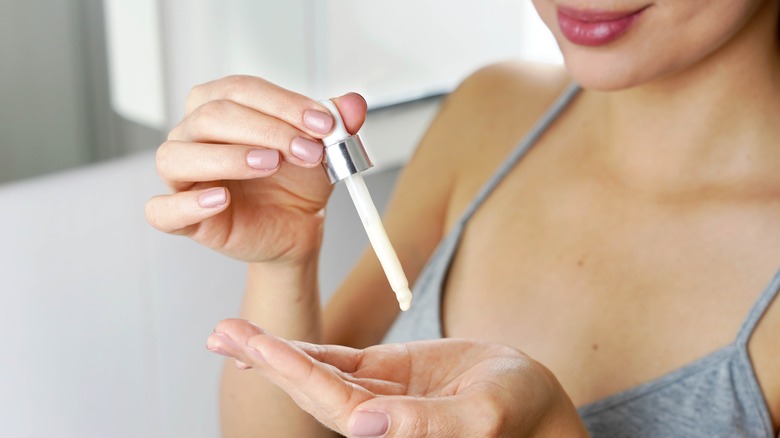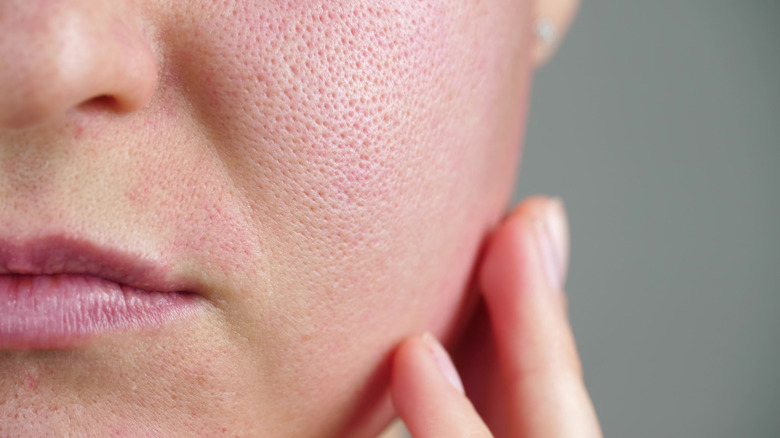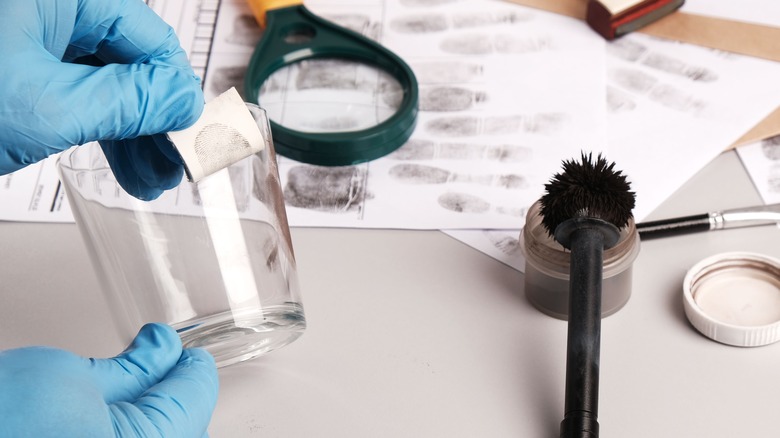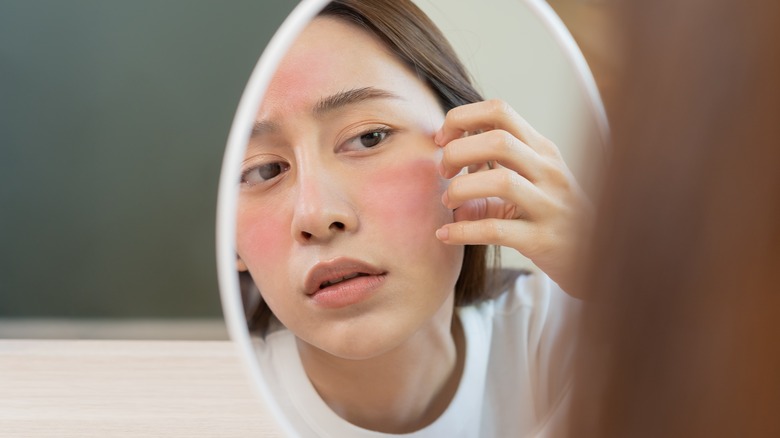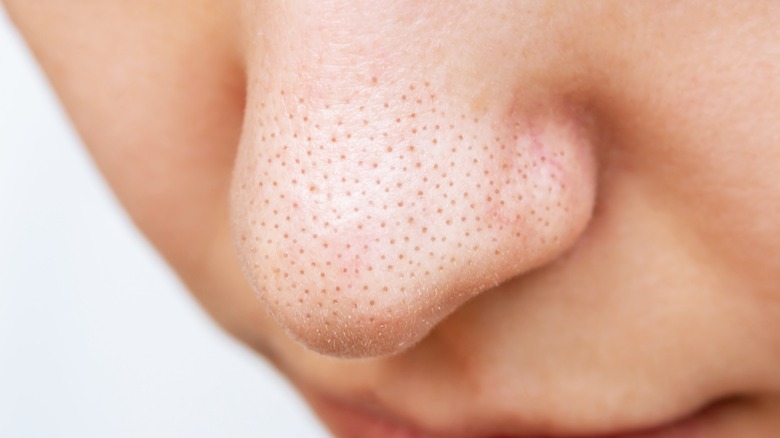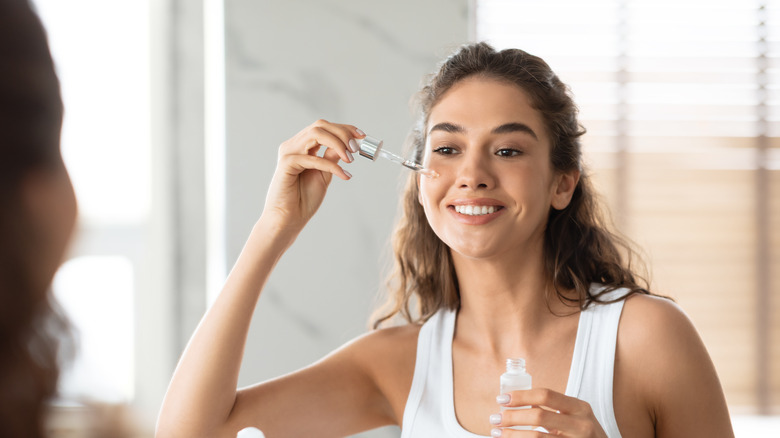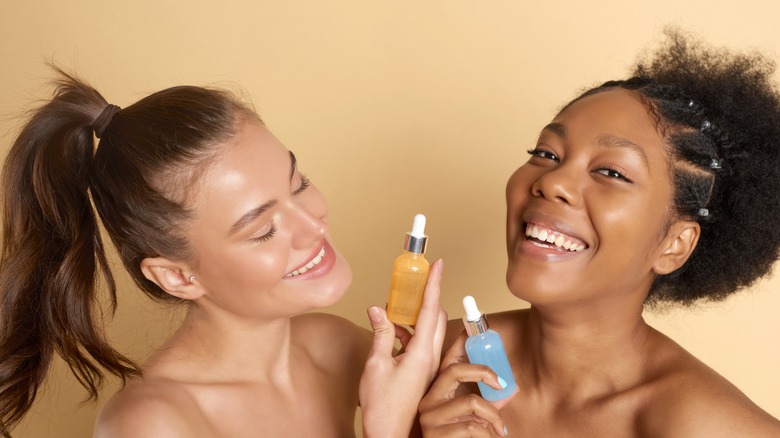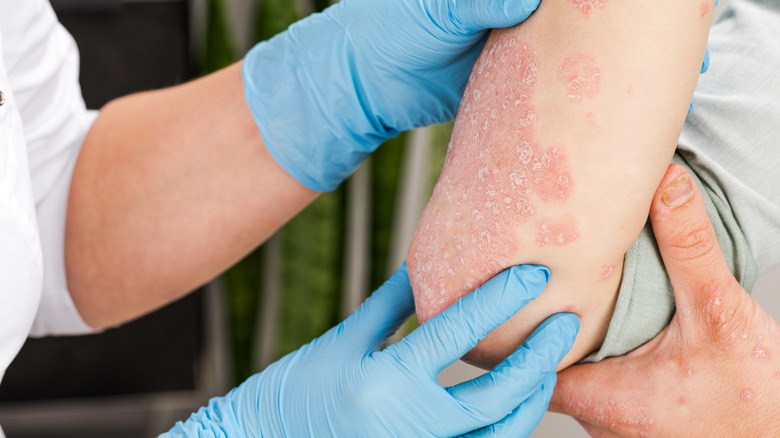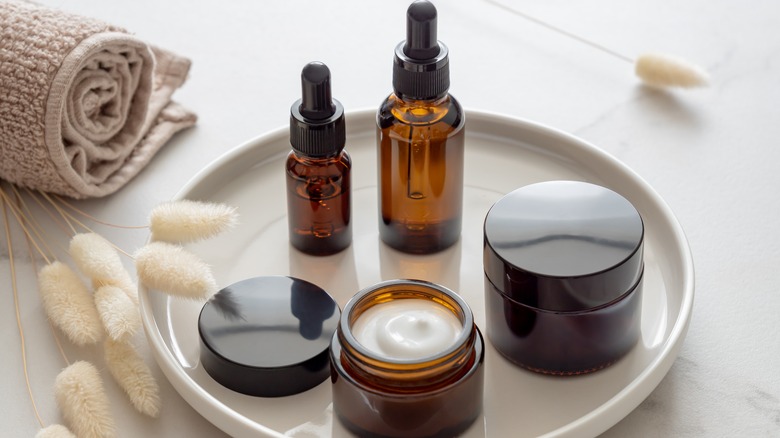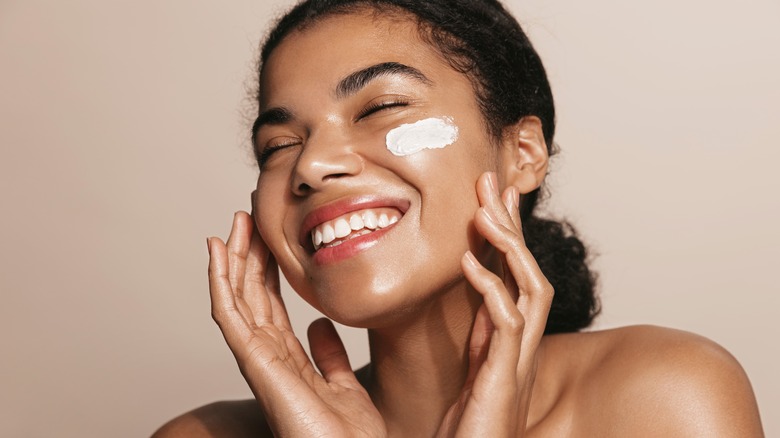Myths About Niacinamide You Should Stop Believing
We may receive a commission on purchases made from links.
Niacinamide is a form of vitamin B3 (niacin) that is essential for many physiological functions in the body. It's an important nutrient that helps support healthy skin, nervous system function, and metabolism. In skincare, niacinamide is a popular ingredient that is known for its many benefits. As the Journal of Cosmetic Dermatology explained in 2004, it improves skin barrier functions, reduces inflammation, and regulates oil production. It is a versatile ingredient suitable for various skin concerns such as acne, hyperpigmentation, fine lines, and wrinkles. It also has antioxidant properties that protect the skin from environmental damage and can even out skin tone.
Despite these benefits, many misconceptions are flying around about the risks and effects of this product. However, it's overall a very well-researched vitamin. Here, we'll clean up some myths surrounding niacinamide and why you might consider incorporating it into your skincare routine. Who knows — it might be what you've always needed.
Myth: Niacinamide is only for aging
If you thought that niacinamide was only for aging, you'd be wrong. It's actually an excellent option for a wide range of skin conditions. For instance, a 2021 study in Recent Advances in Anti-Infective Drug Discovery noted that in addition to aging, niacinamide can be effective at treating "hyperpigmentation, acne, psoriasis, pruritus, dermatitis, fungal infections, epidermal melasma, non-melanoma skin cancer." This is because niacinamide can help to reduce hyperpigmentation and inflammation, which are often factors in many skin conditions.
If we look at acne in particular, niacinamide reduces inflammation by inhibiting the production of inflammatory cytokines (proteins), which can lead to the development of acne. Niacinamide also regulates sebum production by decreasing sebum production in the sebaceous glands. This is important because excess sebum, a natural oil that the skin secretes, can block the pores and cause acne. In fact, according to a review carried out in 2017 published in the Journal of Dermatological Therapy, niacinamide had a 75% (based on six out of eight studies) efficacy rate at treating acne.
Furthermore, niacinamide can help improve the skin's barrier function by increasing ceramide production. Ceramides play a vital role in protecting the skin's barrier. As a lipid, a ceramide is involved in many biological processes, such as helping to prevent moisture loss and protect against external stressors. Having a strong barrier helps prevent bacterial invasion and reduce the chance of acne development.
Myth: Niacinamide can't penetrate the skin
A common misconception about topical skincare products like retinol and niacinamide is that they only deal with surface-level skin issues. But that's not quite true. Put simply, the skin is composed of three main layers: the epidermis (the outermost layer), dermis (the middle layer), and subcutaneous tissue (the deepest skin layer). The epidermis acts as a barrier between the body and the external environment. It comprises several sub-layers, with the topmost layer being the stratum corneum. The stratum corneum is made up of dead skin cells that provide protection and prevent moisture loss from the body.
Niacinamide can penetrate this layer, and reach beyond the epidermis, somewhat into the dermis. Recent research in the Journal of Pharmaceuticals has proven that this is possible by measuring NADP levels in the skin after applying niacinamide. NADP (nicotinamide adenine dinucleotide phosphate) is a coenzyme, meaning it helps to facilitate specific chemical reactions in the body. In the case of NADP, these reactions might be DNA repair and antioxidant defense.
This is important because once niacinamide penetrates the skin, it gets converted into NADP and can get to work on helping to improve overall skin quality. For instance, a study published in The Journal of Clinical and Aesthetic Dermatology highlights that one of the things that niacinamide can help to aid faster skin turnover. This leads to a thicker stratum corneum with greater hydration retention capacity.
Myth: Niacinamide makes your skin breakout
There's a good reason why this myth is so common. Usually, when a skincare product increases cell turnover, many people see acne breakouts. This often leads them to stop using the product, believing it worsens their skin. However, there is a difference between breakouts and purging caused by increased cell turnover. Dermatologist Dr. Rajdeep Mysore explains that in the early stages of using a product that increases turnover, excess skin oil is expelled and may get clogged, causing acne. But, unlike a breakout, this phase will pass, leaving skin clearer and brighter than before. Sounds great, right?
In the case of niacinamide, it's essential to understand that while it can increase the turnover rate, it does not cause cell turnover itself. Since it has anti-inflammatory properties and reduces sebum activity, you're unlikely to see breakouts with niacinamide. In fact, as research published in the Journal of Pharmacology and Physiology pointed out in 2014, in most cases, niacinamide is generally well-tolerated by most skin types and is considered a non-irritating and safe ingredient. So, if you do experience any breakouts or irritation with the product, it could be a sign of an allergic reaction or that you're using a concentration of niacinamide that's too high. In either case, visiting your dermatologist to discuss issues like this is advisable.
Myth: There isn't much evidence that niacinamide works
In case it wasn't apparent from the various research we've already looked at, niacinamide is one of the most well-researched topical skincare products available. In terms of evidence that it works, we could point to the various studies we've already mentioned, but instead, there is a great case that's already been made by two reviews of the product, one in 2017 and one in 2010.
In the first case, the 2017 review published in the Journal of Dermatological Therapy, researchers analyzed the role of niacinamide in skincare treatment for acne to discover its effectiveness and whether it was safe to use. They looked at several different peer-reviewed studies paying close attention to methodology and results. They concluded there was good evidence for the efficacy of niacinamide, low or non-existent side effects, and that, in most cases, it led to a significant reduction in acne. While they do advocate for further study, they don't note any significant concerns about its use.
Likewise, a 2010 review of several popular skincare products published in the Journal of Clinical and Aesthetic Dermatology found that niacinamide was one of the most scientifically-backed skincare ingredients in terms of the amount of clinical research done on it, how it works, and how it truly affects the body.
Myth: Niacinamide can cause dry skin
Whenever we use active skincare ingredients, there is always a chance that they might dry out our skin, so it's not a surprise this is also a concern for niacinamide. However, one of the fantastic benefits of niacinamide is its moisturizing effects. In fact, research published in the International Journal of Dermatology concluded that not only is it unlikely to cause dry skin, but it may also cure it.
As we've already touched on, niacinamide plays a role in strengthening the outer barrier of the skin, which can help avoid moisture loss. Moreover, it also plays an active role in hydrating the skin. Dry skin occurs when the skin loses moisture and becomes dehydrated, leading to flakiness, itching, and tightness. Various factors, including environmental factors, genetics, and underlying health conditions, can cause this.
In 2020 research published in the International Journal of Cosmetic Science, we see that niacinamide supports and maintains the production of natural moisturizing factors (NMFs). NMFs are molecules that are naturally present in the skin and help attract and retain moisture. By assisting in the production of NMFs, niacinamide actually helps to improve skin hydration and reduce dryness.
Myth: Niacinamide can't shrink pores
When you hear about brands or products claiming to shrink pores, in most cases, it's only natural to be skeptical. For the uninitiated, pores are tiny openings on the skin's surface that allow the skin to breathe and regulate temperature by releasing sweat and oil. Pore size can vary, with some people having larger pores than others. As dermatologist Dr. Bobby Buka explains, it is primarily a matter of genetics, so you might be inclined to give up on shrinking them (via The Dermatology Specialists).
Before you do, though, there are a few things worth noting. Although genetics does play a role in pore size, it's certainly not the only factor. Research in the Journal of Skin Research and Technology highlights that pore size is also influenced by skin elasticity, acne prevalence, and sebum secretion. Considering these factors, your pore size might be smaller than you first thought.
For instance, a 2021 study published in the journal Antioxidants illustrated that regularly applying niacinamide could help reduce pore size and skin unevenness by improving skin elasticity and reducing sebum production. How does it do this? Well, we don't actually know yet. However, some earlier research in the Journal of Cosmetic Dermatology suggests that niacinamide can influence or regulate different processes or functions within the body's cells. These cellular functions may include, for example, cell proliferation, differentiation, inflammation, and antioxidant defense mechanisms, among others. By modulating these functions, niacinamide can have various beneficial effects on the skin, such as reducing pore size, improving skin texture and elasticity, and reducing hyperpigmentation.
Myth: Niacinamide causes redness
This one is somewhat true, but only under certain circumstances. To explain, when used correctly, niacinamide does not cause redness. It prevents it. Niacinamide has anti-inflammatory properties, which means that it can help to calm and soothe inflamed skin. The International Journal of Cosmetic Science explains that niacinamide has been shown to reduce the production of inflammatory cytokines, which are molecules that can contribute to redness and other forms of skin damage.
It can also help to reduce the appearance of hyperpigmentation, which can be a contributing factor to redness and uneven skin tone. Research in the Journal of Clinical and Aesthetic Dermatology notes that niacinamide can inhibit the transfer of melanosomes (pigment-containing small units within cells) from melanocytes (pigment-producing cells) to keratinocytes (skin cells), which can help to reduce the amount of melanin that is produced in the skin.
So, why do people associate niacinamide with redness? Dermatologist Dr. Andrea Dray explains that the reasons for redness with niacinamide are little understood, but it could be the result of allergies, sensitivity to other ingredients in niacinamide products, or using too much of the product (as in too high of a concentration). In the latter case, she suggests that using multiple products containing niacinamide can have an accumulative effect, resulting in redness and irritation. So, starting with a low concentration, typically under 5%, is better before moving on to anything higher.
Myth: Niacinamide bleaches skin
Above, we mentioned the ability of niacinamide to inhibit the transfer of melanin pigments to the skin cells. So doesn't this mean that niacinamide bleaches skin? Skin whitening or bleaching is described in research in the International Journal of Molecular Sciences as suppressing a biological process called melanogenesis.
Melanogenesis is the process that produces melanin, the pigment responsible for skin, hair, and eye color. It involves the enzyme tyrosinase, which converts the amino acid tyrosine into melanin through several steps. Bleaching agents, therefore, prevent tyrosinase from playing its role in creating melanin –thus, causing the skin to whiten.
Conversely, what niacinamide does is better described as skin brightening. This is where a product is designed to target a specific discoloration or darkened area, as we see in hyperpigmentation. As research from the British Journal of Dermatology explains, niacinamide does not hinder melanogenesis. Instead, it reduces melanin transfer so that hyperpigmented spots lighten up over time.
Myth: You need sunscreen after using niacinamide
If you've ever used retinol, you'll know that you need to wear sunscreen to prevent damaging your skin in the long run. This is because retinol is an active agent in cell turnover, and your new skin cells are vulnerable without some form of UV protection to help them. However, as we've already touched on, the same isn't true for niacinamide. But you might not have known that niacinamide is practically a sunscreen in and of itself.
According to the study published in the British Journal of Dermatology, topical niacinamide has been shown to protect against UV-induced immunosuppression, a process that can lead to skin cancer. UV-induced immunosuppression is a reduction in the ability of the body's immune system to fight off harmful pathogens or abnormal cells caused by exposure to ultraviolet (UV) radiation from the sun or artificial sources like tanning beds. This immunosuppression can occur because UV radiation can damage the DNA of immune cells and alter their function. As a result, the body may become more susceptible to infections with an increased risk of skin cancer.
The study found that niacinamide increased enzymes involved in cellular energy metabolism and p53, a protein that regulates cell growth and division, preventing cancer. Niacinamide significantly protected against immunosuppression caused by UV radiation and helped to reduce any UV-induced inflammation.
Myth: You can't use Niacinamide with vitamin C
To get to the root of this misconception, we need to look at why some people might think vitamin C reacts poorly with niacinamide. Vitamin C is most well known for its role in antiaging, though it can also be used effectively for hyperpigmentation and UV protection. Furthermore, a study in The Journal of Clinical and Aesthetic Dermatology found that it works by "increasing collagen synthesis, stabilizing collagen fibers, and decreasing collagen degradation," thereby having an antiaging effect.
Regardless, a 1960s paper published in the Journal of Pharmaceutical Sciences on the interaction between a niacinamide derivative and vitamin C (also known as ascorbic acid) suggested that the combination could form nicotinic acid, which can cause redness and burning. This led many to believe that they were unsafe to use together. However, on closer inspection, the paper could be misleading. Firstly, the experiment was conducted under extreme heat, more than 2240 degrees Fahrenheit. In normal conditions, this would never be the case for the daily application of these products.
Moreover, various papers since have actually advocated the use of the pairing. For instance, a 2022 study in the Molecules Journal found that vitamin C and niacinamide reduce skin pigmentation and increase skin elasticity. But not only that –when reviewed together, the study also found that the combination of vitamin C and niacinamide had a greater effect than individual compounds.
Myth: You can't use niacinamide if you have eczema
When you have sensitive skin or eczema, choosing skin products is no easy task. The National Eczema Association (NEA) comments that those with the condition are particularly sensitive to skin irritants or allergens that can cause painful flare-ups seemingly out of nowhere. This is because eczema results from an overactive immune system that causes the skin barrier to become dry and itchy. In other words, it is when the body's immune system overreacts to a perceived threat, such as a virus or allergen, that usually doesn't cause an issue for most people.
This is probably why some might be apprehensive about how their skin could react to a product like niacinamide. However, as a 2021 article in the Journal of Dermatological Therapy demonstrates, niacinamide can improve the signs and symptoms of eczema by restoring the skin permeability barrier in eczema patients, which is believed to be due to decreased levels of ceramides in the stratum corneum.
As we touched on above, niacinamide promotes ceramide biosynthesis — a fundamental process that occurs in all living cells and is essential for the growth, development, and maintenance of the skin's barrier, restores hydration, and relieves itching. As a result, niacinamide is recommended by the NEA as an effective eczema treatment.
Myth: You need a specialized niacinamide serum
Since we've explained the numerous benefits of niacinamide, your first thought might be to buy a specialized niacinamide product like a serum to start reaping those advantages right off the bat. As it stands, the market for niacinamide products is already booming. In fact, it's estimated that by 2028, the global market for the product will be over $665 million. It's sold by popular brands such as The Ordinary, Paula's Choice, and Naturium.
While we aren't saying these products aren't effective, it would be more accurate to say specialized niacinamide might be overkill. Firstly, as we discussed, anything above 5% concentration of niacinamide might trigger redness and irritation, but we see that many of the specialized niacinamide products have concentrations over 10%. Another reason why a niacinamide serum might be unnecessary is that when we reach such high concentrations of niacinamide, i.e., above 10%, this doesn't necessarily improve efficacy.
As dermatologist Dr. Andrea Dray explains, there is no evidence that increasing the concentration of niacinamide makes it more effective. Many high-concentration ingredients in beauty products lose their ability to successfully enter the skin at these levels. Moreover, Dr. Dray observes that if you look at the elements of many popular moisturizers, they already contain niacinamide, meaning that buying another specialized serum would effectively be redundant.
Myth: Niacinamide is a quick fix for skin issues
The last point is probably valid for many beauty and, specifically, skin products. Whether it's acne, aging, or eczema, skin conditions can significantly affect our self-esteem and mental health. This may be why many people seek out quick fixes, feeling overwhelmed by these conditions. However, the truth is that most skin products don't work overnight, and niacinamide is no different.
In almost all of the studies we've discussed here, results from niacinamide were only sought after at least four weeks, with most studies conducted over six to 12 weeks. This is supported by Leslie Baumann's "Cosmeceuticals and Cosmetic Ingredients," in which a review of the different uses of niacinamide, such as for acne, aging, and hyperpigmentation, shows the majority of studies spanned between four and 12 weeks. Based on the nine studies, this would put the average study length at about eight weeks. As such, if you're considering using niacinamide for any of these conditions, it would be advisable to try it out for at least two months to see proper results.
